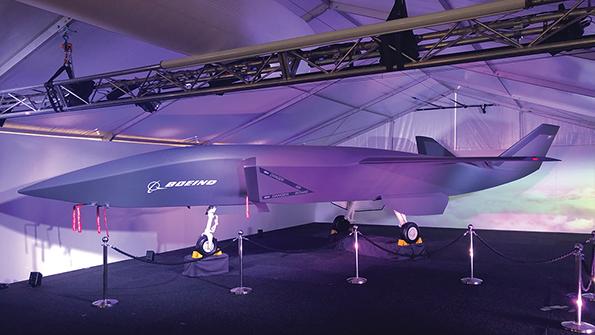
Even the manufacturing locations are being kept secret. Development of a loyal-wingman drone by Boeing in Australia may not be a black program, but it is at least light gray.
Still, the company has let a little light in by releasing a photograph of the first major assembly of the first prototype—its center fuselage. It reveals that the fighter-like Airpower Teaming System (ATS), as the drone is called, has large adaptable spaces for payloads.
- BAE is supplying the flight management system
- The potential production likely will be large
At first, these will surely be for electromagnetic missions: passive intelligence, surveillance and reconnaissance, and perhaps jamming. Yet even the intended tasking of the ATS is not confirmed amid a general withholding of information about the program since its public unveiling in February 2019.
When it released the photograph on Feb. 9, Boeing reiterated the plan for the ATS to fly for the first time this year. The type is aimed at the global defense market, with Australia as the potential launch customer. The 11.7-m (38-ft.) type may be a candidate for U.S. and British programs, too.
BAE Systems says it is supplying the flight-management system among other items, including technology from the British Taranis and Mantis and Australian Kingfisher experimental drone programs. The Royal Australian Air Force (RAAF) is a partner in the work, which the service calls the Loyal Wingman–Advanced Development Program, but has not committed to quantity production.
The potential production quantity—easily hundreds of aircraft—underlines the importance of the location of manufacturing and identity of the manufacturer. In the photograph the major assembly is seen in what looks like a small, new factory.
Asked where the aircraft is being made, Boeing referred Aviation Week to the RAAF. The Australian defense department, responding on behalf of the RAAF, in turn attributed its inability to disclose information to Boeing’s need for commercial secrecy. The defense department “is unable to release information on specific locations at this time due to Boeing customer and supplier sensitivities,” it says.
“Design, development and manufacturing of the prototypes is occurring across three Australian states by more than 22 suppliers,” the defense department says. “Boeing has a number of sites and teams focused on the design, development and manufacture of the Airpower Teaming System.”
The commercial reasons for not disclosing the manufacturing locations are unclear. But the policy also helps keep the details of the design secret.
The drone is aimed at the international market and intended to be cheap—and not subject to U.S. export restrictions. It seems likely ATS would be mostly kept in storage, like missile rounds, minimizing support costs. Hinting at the number of ATS an air force might need, Boeing says it has studied concepts in which 4-16 of the drones would accompany one manned fighter. Even if a customer did not buy at least four ATS for every fighter, unusually large-scale production must be envisioned.
The states involved are evidently Queensland and Victoria and perhaps South Australia. The photograph revealed a conventional structural scheme in which an aluminum substructure was covered by a composite skin. Lining of the inlet ducts also appears to be made of composite. Boeing is presumably making the composite parts at its factory in Melbourne, Victoria, which specializes in such materials.
AME Systems, in Victoria, is making wiring looms. The Australian subsidiary of RUAG, also in Victoria, is supplying landing gear. Globally, RUAG maintains business-jet landing gear, a hint at the origins of the ATS undercarriage.
BAE Systems is making hardware kits including flight control computers and navigation equipment. Its autonomous-vehicles team is in Melbourne, but the company makes electronics in South Australia. Ferra Engineering of Brisbane, Queensland, is making precision machine components and subassemblies, Boeing says. That notably does not include building up major assemblies such as the fuselage.
According to Boeing, the program’s industrial team comprises 16 companies. This contrasts with the defense department’s reference to 22 suppliers.
The ATS appears to be designed for high subsonic speed in level flight; it will need that to keep up with the manned fighters it accompanies. Its single engine is of an unidentified type used in very light personal jets. The Australian government said last year the aircraft could be armed—presumably in a later version.
The RAAF’s head of air-combat capability, Air Cdre. Darren Goldie, underlined Australia’s withholding of a commitment to volume production of the ATS, saying in a Boeing statement that working with the company would help the air force consider options for manned-unmanned teaming. But there is industrial pressure on Australia to place an ATS order: Boeing said last year the fabrication equipment was not too big to be moved to another country.
The major assembly in the photograph is most of the fuselage of the first aircraft, from the well for the nose landing gear to the wells for the main landing gear. If the assembly includes the rear fuselage, the camera angle has been chosen not to show it. Rear fuselages are sensitive parts of stealth designs. That rear was covered on a mockup that Boeing presented at the Australian International Airshow in February 2019. In general, the fuselage major assembly appears to conform to the design of the mockup.
“The next major milestone will be weight on wheels, when the fuselage structure moves from the assembly jig to the aircraft’s own landing gear to continue systems installation and functional testing,” Boeing says. “The Australian team has applied digital engineering and advanced composite materials to achieve cost and agility goals for the . . . aircraft, which is designed to use artificial intelligence in teaming with other manned and unmanned platforms.”
BAE Australia has a strong background in autonomous systems. Apart from the flight management system, it is providing simulation capability, flight control computers and navigation equipment. This equipment will be allied with Boeing’s autonomous mission systems, BAE says. Another partner is the government’s Defense Science and Technology Group.
Visible in the fuselage assembly, are the insides of the inlet ducts. These snake inward and upward to hide the engine face; this is a conventional stealth feature. Access hatches and doors in the belly are hexagonal, a low-observability feature supplementing an airframe shape that appears intended to be highly stealthy. ATS missions must demand a level of detectability comparable to that of the Lockheed Martin F-35 Lightning, since the two types would operate together in Australian service.
Lines of fasteners in the lower corners of the fuselage and the position of frames inside indicate the location of payload bays. These are forward of the main landing gear wells and abreast of the downstream section of the inlet duct, where it would be a single tube. The ATS already was known to have space near the center of gravity for payloads. “Customers will be able to tailor ATS sensors and systems based on their own defense and industrial objectives,” Boeing says.
The bays may open at the sides rather than below. Since fasteners are visible in the photograph, the first ATS prototype will not have full stealth features. The forward fuselage is full of avionics, a source close to the program said in 2019. Conceivably, some of that equipment also could be customized, especially to take advantage of the nose position.
Since the ATS could be armed, designers may intend the adaptable midfuselage spaces to become weapon bays in a later version. The evident size of the bays seems to rule out the possibility of carrying air-to-air missiles, but glide bombs might fit, making the ATS a strike aircraft useful against undefended or lightly defended ground targets. The GBU-39 Small-Diameter Bomb is 1.78 m long, only half as long as a Raytheon AIM-120 Amraam.
An aircraft such as this might be flown for only hundreds of hours, offering the potential to cut structural weight. The fuselage does not appear to have heavy-duty gauges, and elements could be spaced more widely than would be done in an aircraft designed for intensive use. Bent-metal frames abreast of the inlets are much lighter than would be expected on a fighter. The robustness of the overall structure probably is governed largely by maneuver loads, not fatigue life.
The inlet shapes and mild bumps on the sides of the fuselage upstream—seen in the mockup and on the major assembly—correspond to the design of supersonic diverterless inlets, which are stealth features. This suggests the slippery aircraft may be supersonic in a shallow dive, a valuable characteristic in fleeing from enemy fighters. With an engine unlikely to much exceed 3,000 lb. thrust, it could hardly rely on repeated hard maneuvers to survive.
Yet the positioning and shaping of the inlets, suiting high angles of attack, indicates that the ATS is intended to pull high-G maneuvers. Otherwise, stealth considerations would recommend a dorsal inlet. In a Japanese concept, loyal-wingman drones could serve as missile sponges. In that role, an ability to maneuver hard once or twice before running out of energy would be valuable. So would extremely low cost.
The aircraft appears to lack hydraulics, which would be troublesome for long-term storage. Instead, actuation of flight control surfaces and doors may be entirely electric.
The large fuel load for a range (perhaps ferry range) of 3,700 km (2,000 nm) probably is carried at least mainly in the upper fuselage and wing.
—With Guy Norris in Los Angeles and Graham Warwick in Washington

Comments